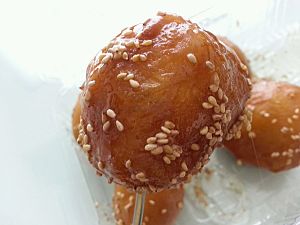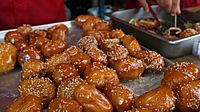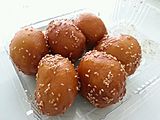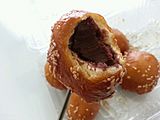Kkulppang facts for kids

Tongyeong-kkulppang
|
|
| Alternative names | Honey bread |
|---|---|
| Type | Bread |
| Place of origin | South Korea |
| Region or state | Tongyeong, Jinju |
| Associated national cuisine | Korean cuisine |
| Created by | Jeong Wonseok |
| Invented | 1963 |
| Main ingredients | Wheat flour dough, syrup, red bean paste |
| Variations |
|
| Korean name | |
| Hangul |
꿀빵
|
|---|---|
| Revised Romanization | kkulppang |
| McCune–Reischauer | kkulppang |
| IPA | [k͈ul.p͈aŋ] |
Kkulppang, also known as honey bread, is a yummy, sticky, and sweet bread. It is filled with a sweet red bean paste. Imagine a soft, fluffy bun covered in a sweet glaze!
This special bread comes from South Korea. The softest kinds are made in a city called Tongyeong in South Gyeongsang Province. These are known as Tongyeong-kkulppang and are a local favorite. In a nearby city named Jinju, you can find Jinju-kkulppang, which is a bit crunchier.
Kkulppang became popular after the Korean War. Many bakeries in Tongyeong started selling it. Fishermen and shipbuilding workers loved it because it stayed fresh for a long time. This was very helpful in Tongyeong's warm weather.
How Kkulppang Started
Kkulppang was first made in 1963. A person named Jeong Wonseok started selling it from a small stand. His stand was in front of his house in Hangnam-dong, Tongyeong.
In the early 1960s, times were tough after the Korean War. Food was often rationed, meaning people got only a limited amount. Kkulppang was made using wheat flour that was available during these times.
Making Kkulppang
Making Kkulppang is a fun process!
- First, wheat flour is sifted and mixed with eggs. This creates a soft dough.
- Next, the dough is rolled into small balls.
- Each ball is then filled with a sweet red bean paste.
- After filling, the balls are deep-fried in hot vegetable oil until they are golden brown.
- Finally, the fried breads are coated with a sweet syrup and sprinkled with toasted sesame seeds. This gives them their famous sticky, sweet finish!
Different Kkulppang Flavors
While the classic Tongyeong-kkulppang has red bean paste, there are other delicious fillings too! You might find Kkulppang filled with:
- Sweet potato
- Chestnut
- Yuja (a type of citrus fruit)
- Green tea
Gallery




